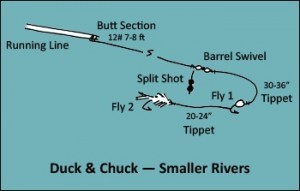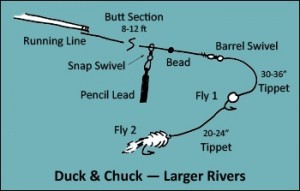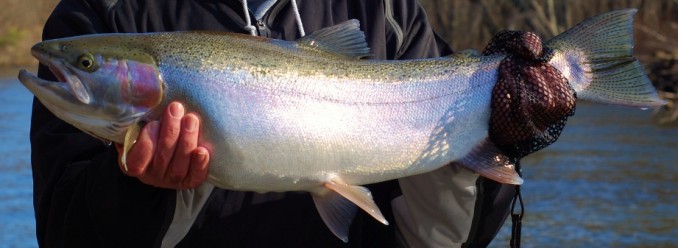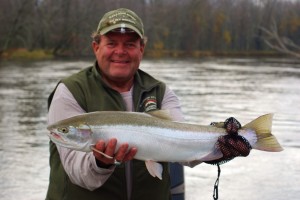 There are a number of ways anglers can pursue steelhead and salmon with a fly, and different techniques require various approaches to rigging: line, leader, tippet &/or terminal tackle like swivels and weight.
There are a number of ways anglers can pursue steelhead and salmon with a fly, and different techniques require various approaches to rigging: line, leader, tippet &/or terminal tackle like swivels and weight.
Just like many things, there are numerous ways of doing something – my goal is to demonstrate some of the most common and practical methods used on Michigan Rivers and their steelhead that have worked for me and my customers over the years.
Duck and Chuck
Probably the most common, effective and easy method for steelhead in the Great Lakes region is Chuck ‘n Duck. This technique gets your fly down quickly and doesn’t require traditional fly casting skills, making for a flat learning curve. Running/shooting line is typically used as the fly line with a butt section attached via either a Nail knot or Albright knot. I prefer to use Maxima 12# Ultragreen or 12# Fluorocarbon if water clarity is a concern.
Smaller Rivers
On smaller rivers like the Betsie, Bear Creek, Pere Marquette, and others, the length of the butt section is usually about 7 to 8 ft because the rivers rarely have holes that approach that depth. I tie the butt section to a quality barrel swivel and leave a long, tag end which serves as a dropper to attach various pieces of split shot. In theory, the shot – if caught – will slide off the line under a deliberate pull, potentially saving your entire rig or at least part of it. If the shot is slipping off the tag easily, tie a double overhand knot to provide a stopper – a must if using fluorocarbon since it doesn’t compress very well when attaching the split shot.
On the other end of the barrel swivel I attach my “leader,” which varies in strength – 5 to 8# test depending on conditions and species. I usually tie my first fly 30 +/- inches from the swivel and the second fly about 24 inches from that; secure the line around the bend of the hook of the first fly. Some like to tie both pieces of leader material to the eye of the first fly – it’s your choice.
Larger Rivers
On larger rivers like the Big Manistee, Muskegon and AuSable where depth becomes a consideration, use an 8-12 ft of butt section. Because flow and depth tend to be greater on the larger rivers, the need for extra weight is also a concern. Rather than use split shot, I use pencil lead, which comes in one-pound coils and can be cut to whatever length/weight is required. A hole is punched through the end of the lead which attaches to a snap swivel running along the butt section.
To change the amount of lead, simply open the snap swivel and replace with a different piece/size. To protect the knot use a 4mm plastic bead (I prefer black) between the sliding snap swivel and the barrel swivel attached to the end. Fly placement is similar to the rig used on smaller rivers, detailed above.
Floating Line & Optional Indicator
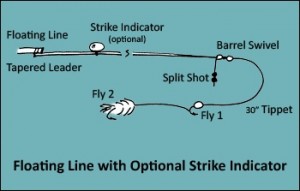 The floating line method has become more popular in the past few years as anglers’ abilities to cast and mend have improved. When used with an indicator, this method offers advantages such as detecting light takes and suspending flies over obstacles on the river bottom. By casting longer sections of line, unlike chuck n’ duck, you don’t need to strip in as much line before recasting. Slightly heavier fly lines like Scientific Angler’s Magnum Taper make casting these rigs easier.
The floating line method has become more popular in the past few years as anglers’ abilities to cast and mend have improved. When used with an indicator, this method offers advantages such as detecting light takes and suspending flies over obstacles on the river bottom. By casting longer sections of line, unlike chuck n’ duck, you don’t need to strip in as much line before recasting. Slightly heavier fly lines like Scientific Angler’s Magnum Taper make casting these rigs easier.
A tapered leader is used with a floating line, attached either by a loop-to-loop connection or Nail Knot. Stiff-butt leaders like Bass and Stripped Bass leaders work well in this application to help cast the weight of two flies, split shot and optional strike indicator. These leaders are typically about 8 feet long. I like to use one that breaks a minimum of 10# test (often I will replace the tippet section of the leader with fluorocarbon for clear water). At the end I tie a barrel swivel and leave a long tag (aprox. 2-3 inches) to apply my split shot to, often with a double overhand knot at the end to keep the shot from slipping off. The flies are attached to tippet/leader material tied to the swivel – 30 +/- inches to the first fly, 24 inches after that.
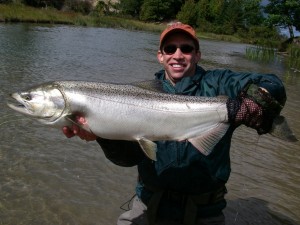 If you choose to use a strike indicator/float/bobber, attach it to the butt section at the proper distance for the depth you are fishing. Indicators like the Thing-a-ma-bobber offer simplicity – quickly add it to your leader and easily adjust it once on. Balsa style indicators like Thill’s Ice’ n Fly cast a little better as they have more mass – I like to run the line through it, and back through again, then adjust the length by loosening the loop and sliding the indicator up or down. When fishing water that is “snaggy,” I like to suspend the flies and prefer a Drennan Piker float. The line runs through the float and is held in place by either bobber stoppers or a heavy piece of mono attached via uni-knot as a bobber stop. The floating line rig is most effective when fishing holes and runs less than 5 feet deep.
If you choose to use a strike indicator/float/bobber, attach it to the butt section at the proper distance for the depth you are fishing. Indicators like the Thing-a-ma-bobber offer simplicity – quickly add it to your leader and easily adjust it once on. Balsa style indicators like Thill’s Ice’ n Fly cast a little better as they have more mass – I like to run the line through it, and back through again, then adjust the length by loosening the loop and sliding the indicator up or down. When fishing water that is “snaggy,” I like to suspend the flies and prefer a Drennan Piker float. The line runs through the float and is held in place by either bobber stoppers or a heavy piece of mono attached via uni-knot as a bobber stop. The floating line rig is most effective when fishing holes and runs less than 5 feet deep.
Float Fishing/Fly-Pinning
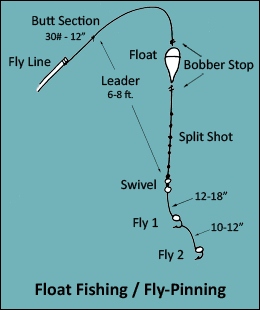 Center Pin reels have become popular over the past decade mostly because of their effectiveness at presenting long, drag-free drifts. Fly anglers have adjusted their tackle and are doing something similar to the Center Pin approach. By using long, 11ft +/- rods, floats and fly lines, fly anglers, too, can get their flies to drift drag-free with lots of careful mending. This is a great way to keep your flies off of the bottom and moving through promising seams. When the float moves, get tight – it might be a fish. Adjust your float length per run to keep it off the river bottom and its snags.
Center Pin reels have become popular over the past decade mostly because of their effectiveness at presenting long, drag-free drifts. Fly anglers have adjusted their tackle and are doing something similar to the Center Pin approach. By using long, 11ft +/- rods, floats and fly lines, fly anglers, too, can get their flies to drift drag-free with lots of careful mending. This is a great way to keep your flies off of the bottom and moving through promising seams. When the float moves, get tight – it might be a fish. Adjust your float length per run to keep it off the river bottom and its snags.
The leader set-up I use consists of 1 foot of 30# Maxima Chameleon attached to the fly line and 10# Maxima Ultragreen, 6-8 ft in length for the large, deeper rivers with a barrel swivel tied at the end. On the other end of the swivel, I tie a leader/tippet approximately 18 inches long to the first fly and 12 inches to the second. When using a Drennan Piker Float be sure to run the butt section through it before tying on the swivel. Attach small split shot along the leader to get the proper amount of weight for depth and flow conditions. This “string” of split shot makes casting easier and helps keep the line directly vertical between the flies and the float making for a better presentation and strike detection.
Swinging Flies
Each year more anglers are swinging streamers, spey and wet flies with sink-tips thanks to the recent popularity of switch and spey/two-handed rods. Single-handed rods work too for this method but don’t have the advantage of line control and ease of casting the longer rods offer.
In almost all cases, swinging flies in Michigan rivers requires a section of sinking fly line, often called a sink-tip. Regardless if you are using interchangeable tip or a fixed length of sinking line, you need a leader. Umpqua makes a Freshwater Shorty leader which is 5 ft in length which will work but I prefer to tie a quick and simple leader – here’s the recipe:
- 18” Maxima Chameleon 20#
- 12” Maxima Ultragreen 15#
- 30” Fluorocarbon – 12# Scientific Anglers or Rio Flouroflex
The different sections making up the leader should be joined by using a blood knot. Once tied, secure the heavy end of the leader by either a loop-to-loop connection or nail knot to the fly line; the fly is tied to the end of the leader with your preferred knot.
With our many rivers in Michigan and throughout the Great Lakes region which receive a run of steelhead and salmon, being prepared with the right equipment can lead to success. These methods are relatively straight forward and should assist in making for some good fishing and if done right, a few fish to the net. Good luck.

